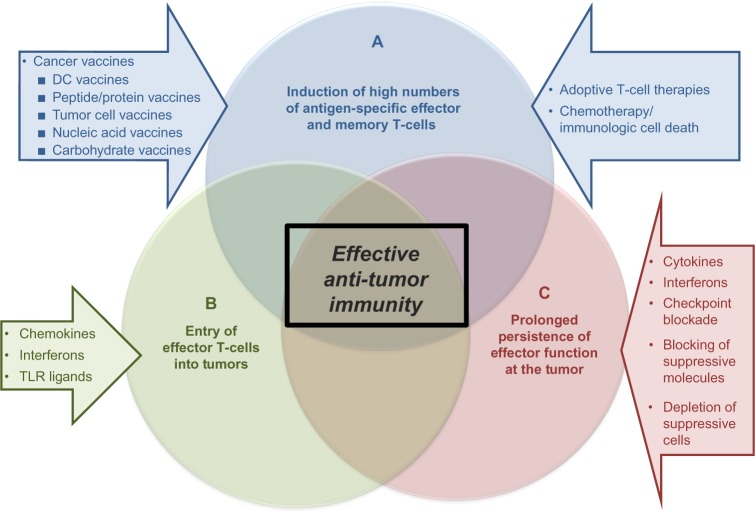Figure 1.
Elements of effective antitumor immunity.
Notes: Effective antitumor responses involve numerous features of immunity. These include (A) induction of high numbers of type 1 (cytotoxic/IFN-γ-producing) antigen-specific T-cells against an established tumor. This can be accomplished with various types of cancer vaccines. Other therapies that are not the focus of this review are adoptive T-cell therapies and certain chemotherapeutic agents that promote immunologic cell death.137,138 Furthermore, the ability of vaccination-induced tumor-specific T-cells depends on the T-cells’ ability to enter tumor tissues (B), which can be facilitated by manipulations aimed at local induction of effector cell (cytotoxic T lymphocyte, type 1 helper CD4+ T cell, natural killer)-attracting chemokines, especially when accompanied by suppression of factors that attract undesirable suppressive cells, such as myeloid-derived suppressor cells and regulatory T-cells. Finally, sustaining effector functions at the tumor site (C) can be supported by promoting effector T-cell activity and prolonging T-cell memory, which can be achieved with administration of cytokines such as IL-1, IL-7, IL-12, and IL-15 or IFNs, and by counteracting immunosuppressive mechanisms using checkpoint blockade of cytotoxic T-lymphocyte antigen-4 or the PD1-PDL1/2 pathway, blockers of immunosuppressive molecules like prostaglandin E2, indoleamine 2,3-dioxygenase, nitric oxide synthase, vascular endothelial growth factor, and transforming growth factor beta, or depletion of immunosuppressive cells such as regulatory T-cells and myeloid-derived suppressor cells.
Abbreviations: CD, cluster of differentiation; DC, dendritic cell; IFN, interferon; IL, interleukin; PD, programmed death-1; PDL, programmed death ligand; TLR, toll-like receptor.

